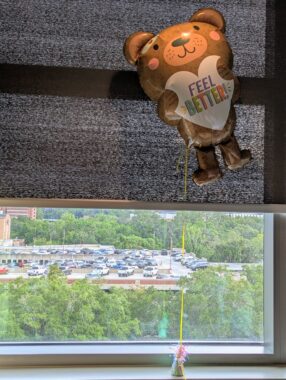What remains when the miracle doesn’t
9 years after my stem cell transplant, I'm facing a new stage of my MS

For years, the date of June 22 marked the anniversary of an autologous hematopoietic stem cell transplant (aHSCT) that gave me back a kind of life I never thought I’d taste again. The date marked a milestone I clung to like a ribbon at the finish line, a sign I’d made it. I’d survived a decade-plus with relapsing-remitting multiple sclerosis (RRMS). I rebuilt.
It’s been almost nine years since I underwent aHSCT, and for nearly a decade, it worked. My MRIs were clean. My body was mostly quiet. The MS that once stole my vision, my mobility, and my trust had gone still. I got my miracle. I learned how to live in remission and how to slowly trust my body again.
Every year, I’d honor my “stemmie” day in some way. The celebrations began with adventures, including kayaking, a ropes course in the trees, or hiking in a nature preserve. The goal was to recognize the gift I’d been given by accomplishing something I wouldn’t have been able to complete when my active disease stood in my way. As the years progressed and time was scarce, I still found a way to incorporate a quiet post, sharing a photo of an iris or a note of gratitude.
But this year is different.
An unexpected relapse
Instead of celebration, this year I’m recovering from a relapse, from five rounds of plasmapheresis, from a round of rituximab (often known by its brand name, Rituxan), and from the kind of invisible unraveling only an autoimmune disease can orchestrate.
Just shy of my ninth stemmie birthday, I found myself in an odd parallel to my transplant. On June 9, 2016, I’d arrived at the Pirogov Clinic in Moscow to begin aHSCT. This year on June 9, I checked into the hospital facing disease reactivation. Two new lesions — a brain lesion and one involving my spinal cord — are active. Because of damage in the dorsal column of my spine, I feel like I’m wearing compression stockings made of sandpaper from the waist down.
I’m currently sitting in discomfort in more ways than one. I’ve spent the past two weeks under fluorescent hospital lights, trying to make sense of the fact that the miracle didn’t last forever.
It’s not just the medical facts that make this moment nearly intolerable; it’s what they represent. I fought my way through hell and genuinely believed I’d made it out. That I’d done enough. Sacrificed enough. Rebuilt enough. That, maybe, I’d finally paid my dues.
But this disease doesn’t work like that. It doesn’t care how hard you’ve worked or how long you’ve been stable. And when it comes back, it doesn’t knock gently. It breaks in through the back door uninvited and reminds you that you’re still living in a body you can’t entirely trust.
Miracles, it turns out, aren’t always permanent. They’re not lies, either. Maybe some are just temporary.
Where I am today
This flare doesn’t erase the remission that came before it. It doesn’t erase the years I got back. And it certainly doesn’t undo the prior healing. It does, however, challenge everything I thought I knew about what it means to be “done” with something.

A bear balloon in my hospital room serves as a reminder that levity and love can rise even when the ground shifts beneath me. (Photo by Ahna Crum)
So now I’m learning how to begin again. Not from square one, but from within a body that holds both proof of healing and evidence of harm. Because I may not be able to escape my health. But that doesn’t mean it gets to steal my life.
This week there will be no kayak, no ropes course, no celebratory hike. But there will be meaning — woven not through victory, but through endurance.
I’m celebrating the doctors who listened, nurses who made space, friends and family who helped shoulder the weight. There have been moments of levity tucked between treatments: flowers, card games, bear balloons, and hospital coffee made bearable by company.
There will be waves of grief that catch me off guard, I’m sure. But there will also be ground beneath my feet. There’s still a steadiness that’s a reminder that I’ve walked through this fire before, and I know how to begin again.
Maybe survival looks different this time — not in the miracle of disease silence, but in adapting, showing up, and continuing anyway.
The anniversary still matters. It just means something different now.
Note: Multiple Sclerosis News Today is strictly a news and information website about the disease. It does not provide medical advice, diagnosis, or treatment. This content is not intended to be a substitute for professional medical advice, diagnosis, or treatment. Always seek the advice of your physician or other qualified health provider with any questions you may have regarding a medical condition. Never disregard professional medical advice or delay in seeking it because of something you have read on this website. The opinions expressed in this column are not those of Multiple Sclerosis News Today or its parent company, Bionews, and are intended to spark discussion about issues pertaining to multiple sclerosis.







Rene Köck
Thank you for your honest report! Best wishes from Austria!
Ian R
Bless you Ahna.
I had alemtuzumab in 2006 and 2007 (in my early 40s). It served me well for the first 10 years (no relapses), but I’ve noticed slow worsening since c.2017. I took early retirement and turned 60 earlier this year. I now use a cane when outside the house. I thought my treatment might shut MS down for good, but it seems that it’s always there in the background. What you’ve done is buy yourself time. New treatments are coming (BTK inhibitors, Cart T cell therapy, remyelination therapies). I expect we’ll see some announcements about these new therapies by the end of the year. Keep yourself fit and strong so that you’ll hopefully benefit from some of the new therapies on the horizon. Best wishes.
luis fernando
Stay strong
Dont give up
Daryl Melancon
WOW almost ten years of getting your life back, would like to ask a few questions if you’re willing to answer them.
1. What kind of stem cell therapy did you use at first ,bone marrow cells, umbilical cord cells or fat cells from your own body.
2. Are you going to do the same stem cell treatment again
Thanks for sharing your experience
Daryl
allan flood
A wonderful story! I've had MS for 45 years and my biggest issue has been letting go of the past and accepting what is instead of the loss of what was, being in the present instead of the past.
Wendy R Hovey
This is brilliantly written, and I pause to applaud your talent. I hope that it can be a prominent part of this new phase. But the message is so much more than talent. Insight, courage, candor. Thank you especially for those.
MADELINE l NEWTON
wow you are strong and it had shown you that you could .sorry it had to reappear to show you who is stronger ...so glad you aren't afraid of this terrible monster that we all have to deal with ...i am very proud of what you have gone thru and now fighting again to fight back for what you want back again...that is why i call MS a big MONSTER..it is alway there but we do have to keep fighting for what we want in life ...love and happiness for you and so much more ...keep on fighting the MONSTER...
Amanda
I am glad you shared this. I was 10 years with no medication and I was fine. That is until last year when I got my first ever MS Hug that affected my walking and I finially fell at work and broke 5 ribs. MS is a sneaky bastard!
Amanda
Lisa Kandel
God bless you and make you a blessing! I will pray you recover from this latest relapse. Stay strong and look up!